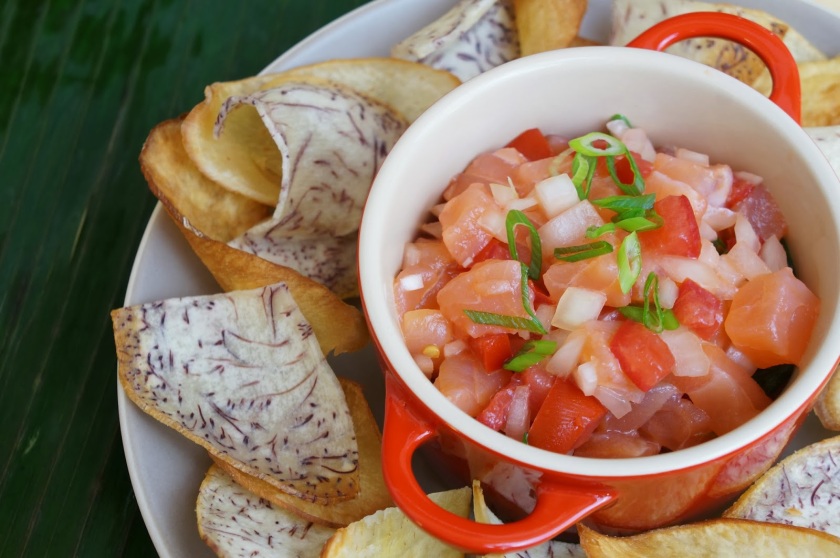Even though salmon don’t swim close enough to Hawaii to be caught in its surrounding waters, early European explorers, missionaries, whalers, and the armed forces exposed Hawaiians to salt salmon (and many other types of salted, dried, or canned meats, such as Spam). It has become so integrated into Hawaiian cuisine that lomi lomi is a traditional luau (wiki) dish.
The salt salmon needs to be made at least 1 day ahead, so start this recipe a day before you want to serve it.
 Food Safety:
Food Safety:
Use only very fresh high quality salmon, preferably sashimi/sushi quality, since the raw salmon is only lightly cured (see here for more information about what types of salmon can be eaten raw and also this wikipedia article on raw fish). I used sushi salmon (from Super Mira Market in San Francisco) to ensure that it was safe to eat raw because it has been commercially deep frozen to remove any parasites (home freezers are not cold enough), very fresh, and had a great texture. If you can’t find sushi salmon, then you could consider using farmed salmon but don’t use wild salmon. Since wild salmon swims in fresh water, it can pick up parasites and should only be eaten fully cooked. The diet of farmed salmon is controlled, so it is less likely to have parasites.
Source: Modified from “Capt. Mike’s Lomi Lomi Salmon” from FishMaui.com
Lomi Lomi Salmon
Ingredients:
- 1/2 lbs sushi salmon
- 1/2 Tbsp alaea Hawaiian salt (10 g), or substitute 1 Tbsp Diamond Crystal kosher salt. Iodized table salt cannot be used.
- 1 small tomato, preferably a flavorful meaty type since it will be deseeded, such as Early Girl.
- 1/4 to 1/2 of a small sweet onion, preferably a Maui onion
- 1 green onion, thinly minced
- (optional) taro chips, or substitute a different type of compatible crisps or chips
Make the salt salmon 1 day ahead:
Cut the salmon into pieces no thicker than 1/2 inch. Mix with 1/2 Tbsp alaea Hawaiian salt. Layer the salmon in a wide container with a tight fitting lid; the pieces can be overlapping or stacked in a thin layer. Cover with plastic wrap and then cover tightly with the lid. Refrigerate for 24 hours or up to 3 days (I did 24 hours). A longer salting period will result in a saltier and more heavily cured fish, and more water will be pulled out of the salmon.
Mix the lomi lomi:
Thoroughly rinse the excess salt off the salmon. Cut off a small piece of the salmon and taste it. It will be salty, but if it is too salty, you can soak it anywhere from 3 hours to overnight, changing the water occasionally; however soaking will also remove some of the salmon flavor. (I only needed to rinse mine really thoroughly.)
Dice the salmon into small cubes about the size of a pencil eraser. Finely mince the onion; the pieces should be half the size or even smaller than the salmon (if the onion is very bitter, you can soak it in water for a few minutes and then drain it to remove the bitter juices). Finely mince the green onion. Deseed the tomato and dice it into cubes which are slightly smaller than the salmon.
Place the diced salmon in a mixing bowl. Reserve a small pinch of green onions for garnishing; add the rest of the green onions into the bowl with the salmon. Gently mix in the tomato and onion to taste (lomi lomi means “massage” in Hawaiian). You might not use up all of the tomato and onion; I like my lomi lomi to be mostly salmon with a little bit of tomato and onion since the salmon is the good stuff, though some people like it to be half salmon and half tomato and onion. This mixture can be made ahead of time and refrigerated for several hours or overnight in a covered container.
Serve very cold. In hot places like Hawaii, this is often served over ice or even with a few cubes of ice mixed into the lomi lomi (the melting ice also makes the lomi lomi have a wetter sauce; you can add a small amount of water if you prefer this consistency). Garnish with the reserved minced green onion before serving.
Optional Variation: Mix in a few drops of Hawaiian chili pepper water. I didn’t add any Hawaiian chili pepper water to mine, but I assume this would be a nice addition. See “Capt. Mike’s Lomi Lomi Salmon” from FishMaui.com‘s recipe for how to make chili pepper water.
Optional Serving Suggestion: Serve on its own as an appetizer or with chips. Taro chips would be a good choice since taro is frequently eaten in Hawaii since it was brought to the island more than 1,500 years ago by Polynesians (wiki). A recipe to make taro chips is here. Or substitute another type of compatible crisp or chip, such as yuca. Yuca, which is also called cassava (but isn’t the same as yucca (article)), isn’t commercially grown in Hawaii, though it is found in Hawaiian gardens as a decorative and edible plant (article)). The picture below shows both taro chips (the white chips with purple lines) and yuca chips. An innovative alternative is to serve it with lightly salted fried shrimp chips.

